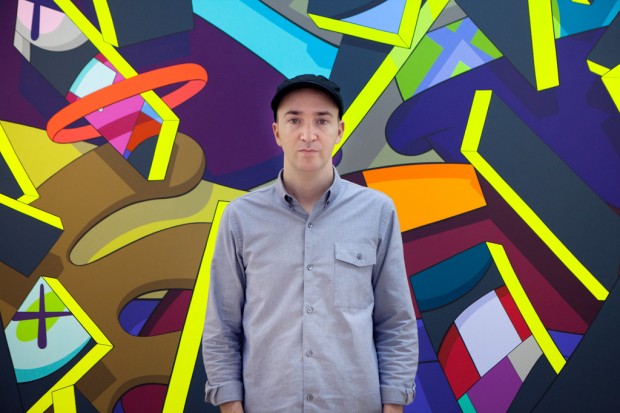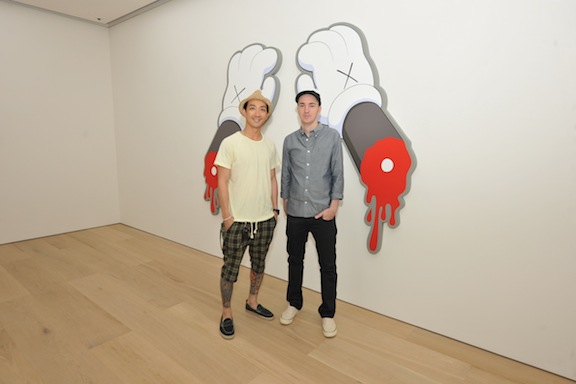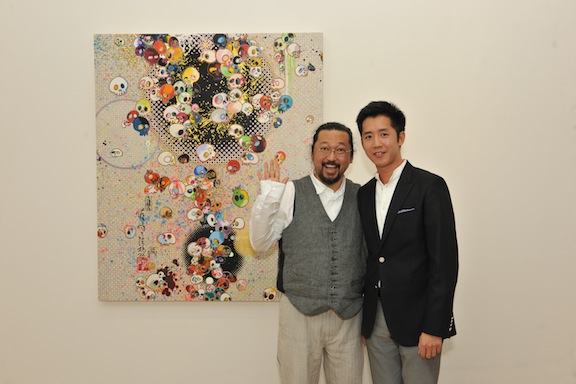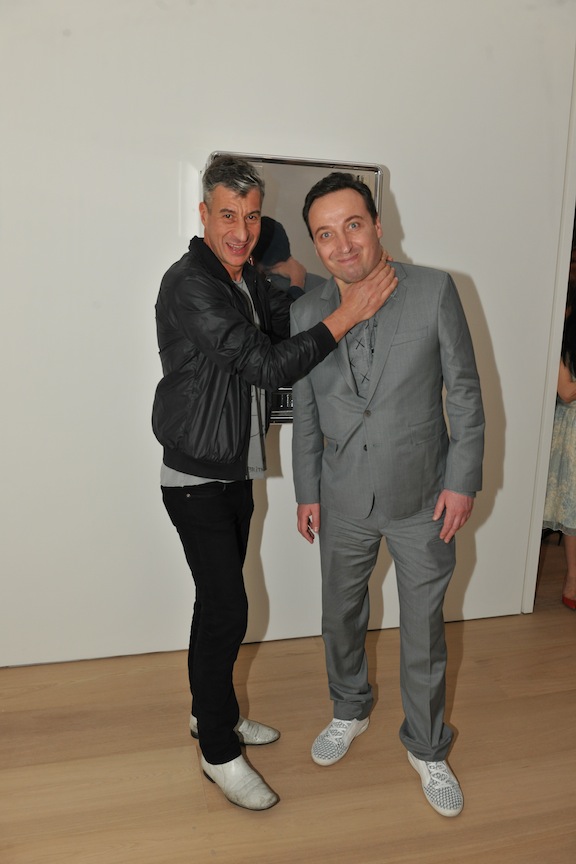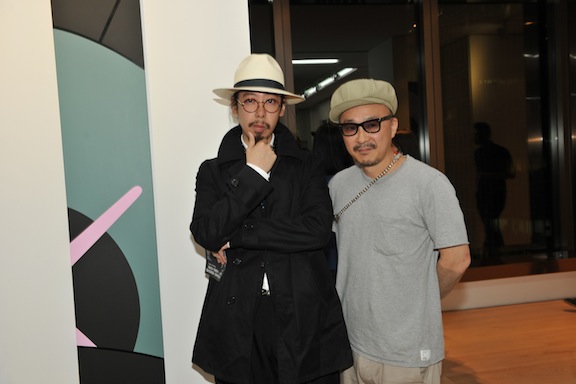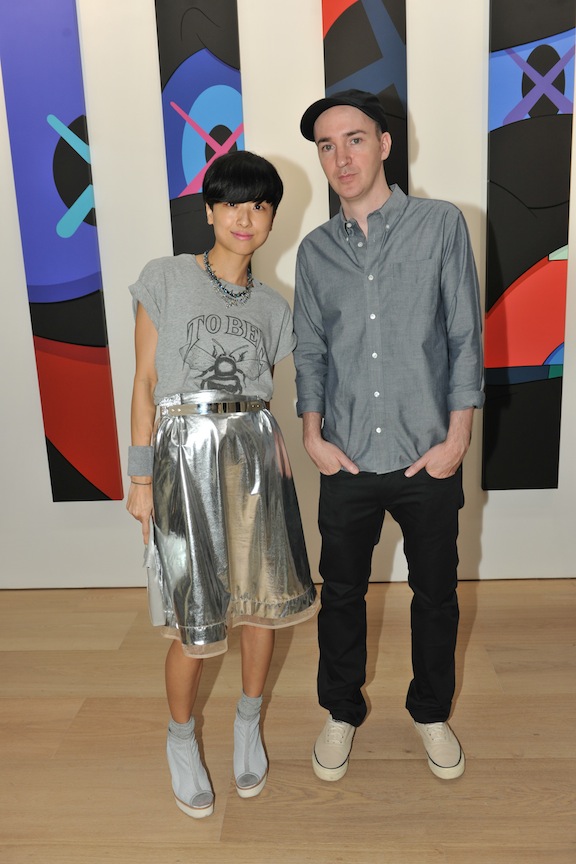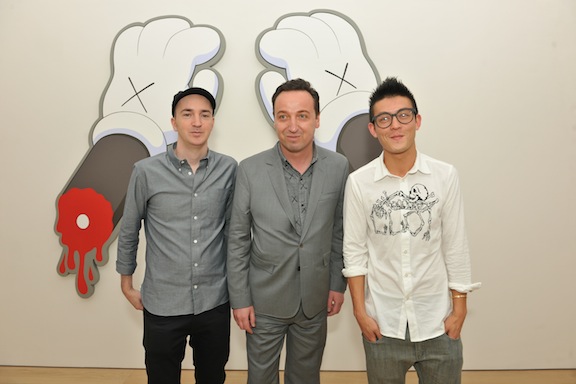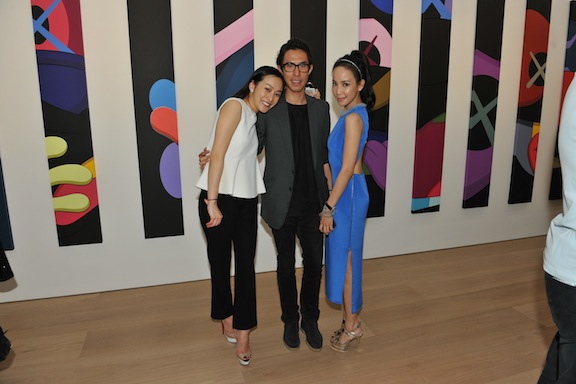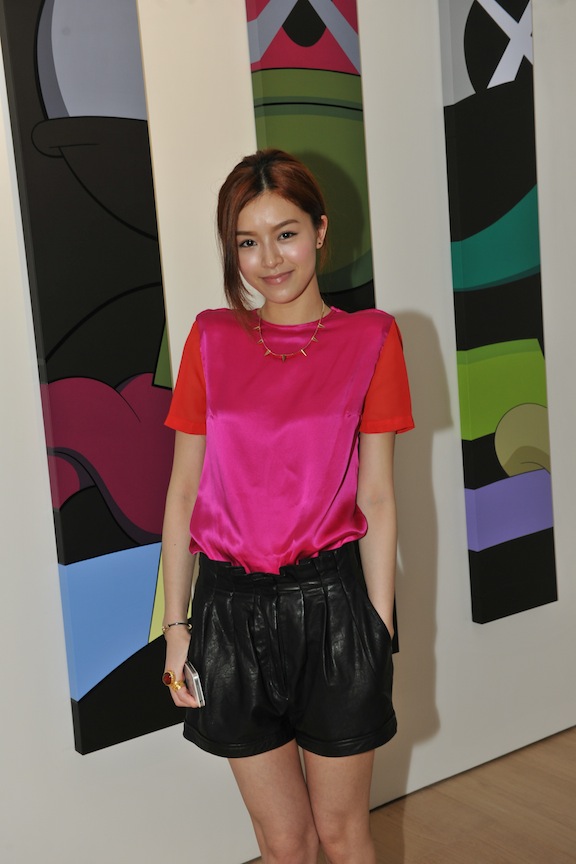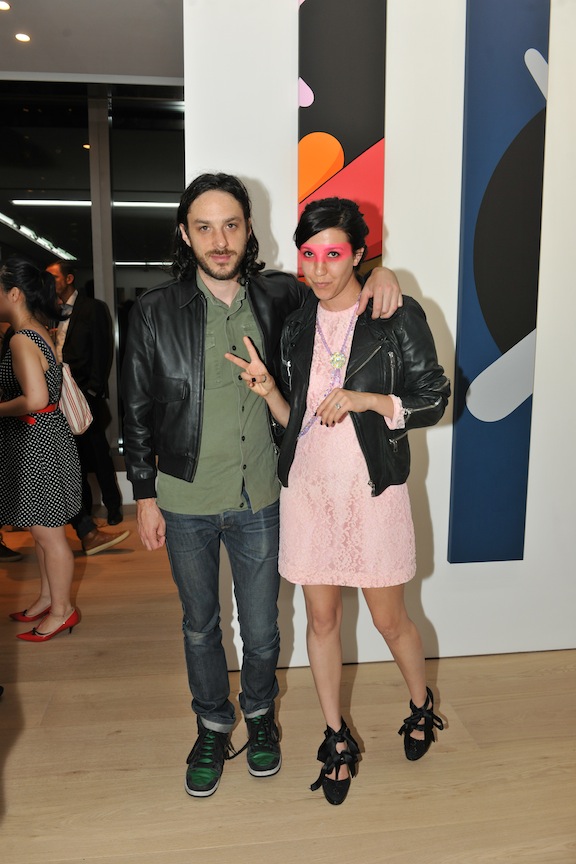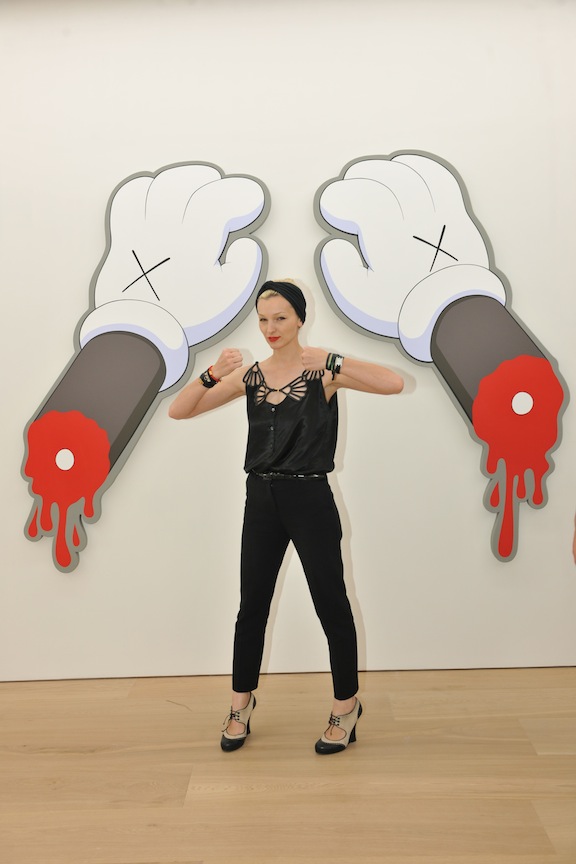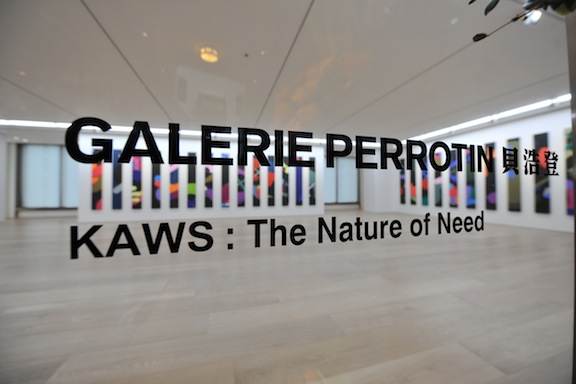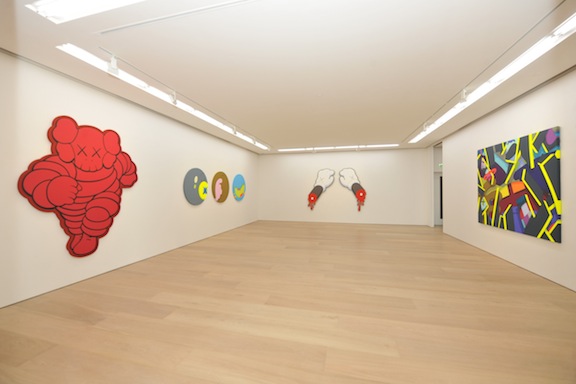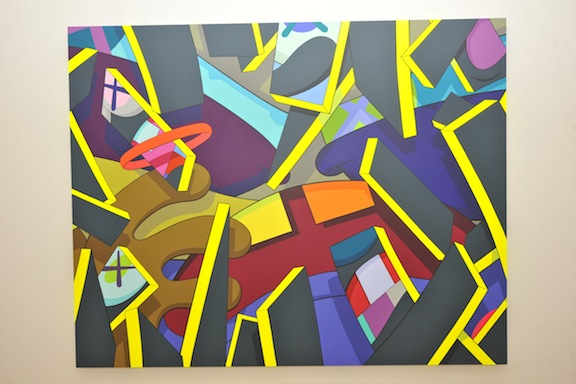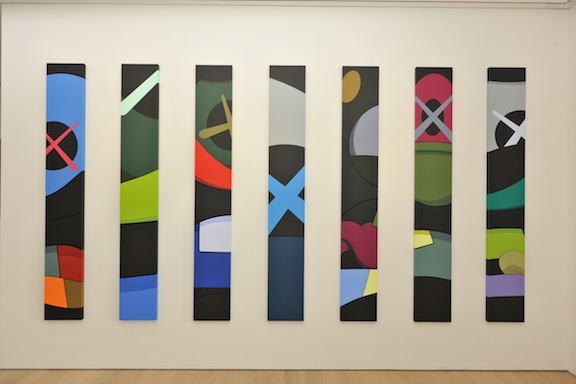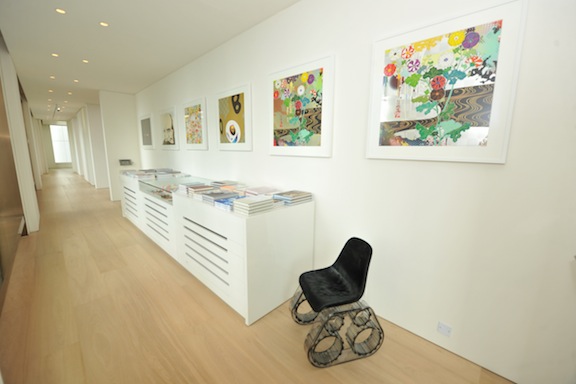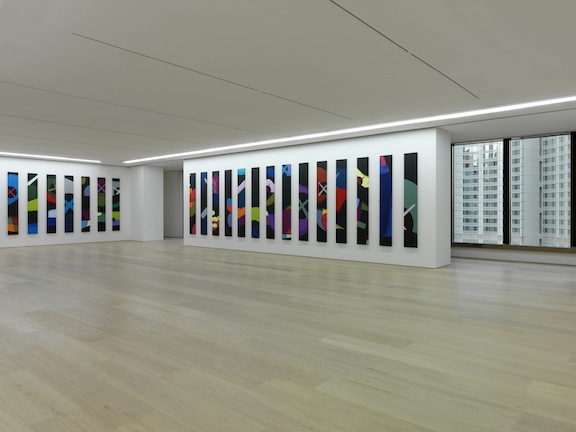Hypebeast Interview –
What exactly is the theme of your latest “The Nature of Need” exhibition in Hong Kong?
It’s not exactly a theme, but more a continuation of the painting series that I’ve been doing. I wanted to do a show that just focuses on painting this time. I think I’ve been wanting to do these vertical paintings for a while. I did some when I did the Aldrich show in 2010. I had one painting that was seven feet tall by one foot wide. If it wasn’t for doing that mural I would have never considered that composition; but after doing it, it has just been on my mind to do a strong series of them. Seeing this space, I thought it would a good time to pair this, so it’s like an installation or they can exist on their own.
You currently have “Down Time” running in Atlanta and now you’re opening in Hong Kong again. Does the geographic location of where you are showing ever factor in or influence what you are going to paint?
No, I don’t really think geographic locations have anything to do with it. The work I am going to make is the work I am going to make. A lot of times when installing the work, I respond to the architecture of the space and I pay attention to the individual paintings. I also want to think about when somebody walks into the space that it’s not just them with that one image. You have to consider everything in their peripherals.
Did you see the Galerie Perrotin space prior to coming to Hong Kong?
No, this finished space was just completed; but I had a model made in my studio for about six months. Coming here earlier in the past two months kinda simulated things and I could make a pretty exact replica of what the show would be, before I even walked into it.
How do you think your personality is reflected in your artwork? Or is there a disconnection at all?
There’s definitely a connection. I mean, it’s just sort of the work I’m making at the time or getting a feel for the kind of the mood I am at during the time. Like if there are periods in life that are chaotic, this will be reflected to some degree in my work.
How do you approach other projects with companies and collaborators? What is the connection between your personal work and other work?
If I am approached or if there is an opportunity to do a collaboration with a company, the projects I make at that time have to align with my personal work at the time. So, it is actually that when the “other” work comes in, it sort of falls within those parameters of what my personal work is during that period. Whereas with this work for “The Nature of Need,” it’s just what I am making as a sort of growth and progression from my past personal work. For projects like Ikepod or Hennessy the best way to treat collaborations and projects like that is to do exactly as I am doing at that time and it always seems fresh for me. It’s always a way to sort of maintain interest in what I am doing – regardless of what the project is. I get requested all the time to do something specific, like something I was doing 10 years ago. That doesn’t interest me, because I always strive to continuously grow and progress.
Is there ever a process where you actually reach out and want to do a project with a brand or company or is it always a one-way direction with them approaching you?
As far as the commercial sort of collaborations, there’s some I want to do such as the toys and OriginalFake products. But, there are some times when we may reach out to Disney or Warner Bros. – I actually have one project coming up with a company and I actually had to go out and talk to them and explain my interest. But, a lot of times for projects like Hennessy or Ikepod, it just sort of happens naturally or they approach me. It has to make sense to me and the work.
Your works often possess a high level of technical aspect of the shading, the proportions, and perspective. It seems like brush strokes are nearly impossible to see and the nuances are few and far between. What is something you are most proud of in terms of your technical skill when it comes to painting?
Well – to say that “I am most proud of this” sounds kind of corny (laughs). But, I have been painting my whole life. I truly enjoy painting and I worked hard so I can be in a position to paint. When I am painting, it’s a really good time for me. I can zone out on most other things in life and can just be in the studio and focus. I did make it a point in recent years to begin trying to do more exhibitions as a way to get my paintings in front of people. Because, you can make something look so good in a print magazine or online using vectors and other things like that; but people can assume that that is all there is to it and it’s just manufactured. It’s only when you are right in front of a painting that you see that everything is actually done by hand – there’s no masking, it is actually shaky in some places and there are some subtle nuances that are unavoidable. I aim to make something as straight as possible of course, but in the end, it’s going to be a little fucked up in some places – but, that’s the quality I like.
You seem really hands-on with all the work, even down to the day of the gallery actually hanging pieces and helping out with the setup. How important is this process for you and making sure things come out true to your vision?
(Laughs) I don’t know if that is a good thing or a bad thing! But, no – I mean I wouldn’t take so long making a painting and then just go and let people do whatever with it, you know? But, I also believe that “true to your vision” doesn’t necessarily mean that you need to be hands-on with everything. I know there are plenty of artists that operate with large studios and maybe not even ever touch their paintings; but their paintings are still true to their vision. I don’t think there is a right or wrong way to do it. I have two assistants that help me paint and fill in. There’s things that they can do that I don’t need to be doing. I don’t need to be painting the same white square 15 times in a row — a lot the colors you see are bright like that because it is painted over and over in the same shade. The same way that I’m not at the factory making each one of my toys, but they are exactly what I want so it’s just a matter of figuring out what’s possible and what you need help in. I try to find a balance where, yes, of course I want to control the painting and have it come out exactly as I want but no, I don’t want to spend the entire time doing something that I can easily allocate to somebody who is competent.
So I guess for a lot of artist who have become successful as a business per se, do you find you have had to develop a certain business sense along the years?
It’s not that I felt I had to develop it. My business has grown organically and over a long period of time so I had a long time to really figure things out along the way. The best way to learn is to just get burned. Once you get burned over and over, these red flags go up so that when a situation is in front of you, you are seeing the burn potential before they open their mouth. That to me is the best way to do it, just throw yourself into the fire and in the end it’s just art and designing shit. Nobody is trying to kill you. So there’s nothing that can happen that’s too bad.
Do you feel you have any limitations right now?
Not really. It’s sort of like what I was just saying before. What are the consequences to trying? I could fuck up really bad and lose my savings and I’d be broke. Big deal. I’m not a flashy person so I can easily go back to zero and work my way back up, it doesn’t scare me.
You’re in Hong Kong right now for “The Nature of Need.” The city has seen so many big galleries open up here recently. What are your thoughts on how these big galleries will hopefully enhance the level of art in the region, or do you think it won’t have an affect at all?
I hope it will have an effect. You can’t really depict what will happen but it’s great for kids to have that option — to go to a gallery like Perrotin and see a whole roster of French artists, artists from Japan, artists from New York, and the more and more that these options are placed with these new galleries opening up, the more people can make a choice. If they want to see it, now they can. Whereas before, if they wanted to see it, they couldn’t. I think it’s a positive step.
I think that there’s always been this pretension that has surrounded art, but for Hypebeast, we cover all spectrums because we feel it’s all worth knowing, and it’s up to you to decide. But, I think that’s something that you can really appreciate about the Perrotin space – You don’t really need to be a guy that knows this art history, it’s more for the consumer.
For me as an artist and having my background, and having the various channels I’ve worked in — somebody could just come to the gallery knowing some specifics from my work, but then see a Kaz Oshiro piece in the other room, and then slowly follow that rabbit hole and start to learn about his work. And it’s the same thing when I go see an artist: you learn a little bit about them and what their peer group was and you start getting curious. “Oh if they were both painting in the sixties in the city, who else was with them cause I’m into this?” I think it’s the same with anything, like music for example. You find out about musicians and you learn from their associations, and it’s the same with art galleries.
When it comes to being under Perrotin’s roster of an eclectic mix of artists, do you have to entrust them to curate you properly? Is there any trust issues when being represented by them, and being placed next to any other artists within that roster?
I think that’s something you have to think about as an artist. I like working with Emmanuel because he does have a really diverse program. And it’s better than being with an artist that only shows people who paint blue or something like that. You can definitely find these niches that I try to avoid. But it’s the same thing with working. I feel that there are people that know me as a toy designer and will only think of me as a toy designer, or a graffiti artist or a street artist. Yet, throughout all those phases, I could care less about carrying the flag for this movement or that movement. I’m more thinking about the work I want to make and getting the work out. So even now with me doing this show I don’t want to be thought of as a gallery artist. I’d rather them say this is a project he did, and he can do this, or work in this way.


